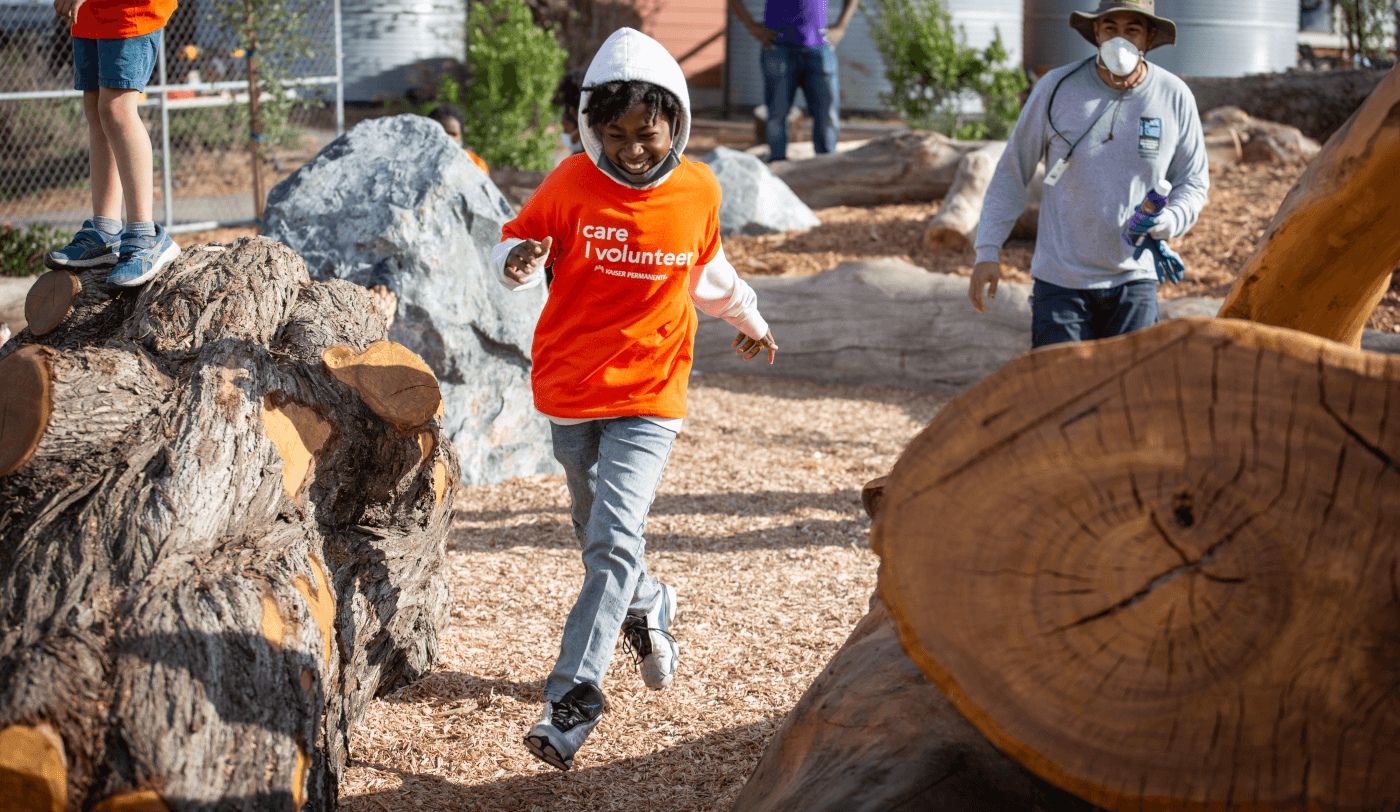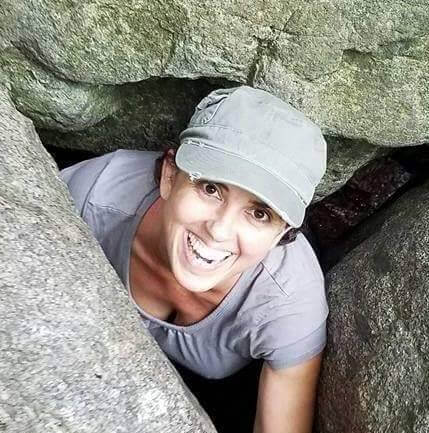Lessons learned from 9 years of Cities Connecting Children to Nature
In Milwaukee, Wisconsin, the public school district unveiled five new greenspaces and playgrounds as part of its district-wide green schoolyard plan. In Rochester, New York, the city built a nature center as a way to bring nature and outdoor activities to all children in the city. In Cincinnati, Ohio, the city’s “Green Cincinnati Plan” includes a goal to guarantee that 100% of public schools have safe and accessible outdoor learning spaces by 2028.
Since 2014, nearly 50 cities across the United States have chosen to prioritize youth nature connection by participating in the Cities Connecting Children to Nature (CCCN) initiative, a joint national partnership between the National League of Cities and the Children & Nature Network. With a growing number of cities interested in making children and nature a priority, understanding the lessons learned from this initiative is increasingly important.
CCCN’s vision is to achieve “a world where children have access to the benefits of nature everywhere they live, learn and play.” As the United States’ urban population grows, CCCN understands the need for new ways of working that pair the grassroots children and nature movement with municipal leadership to create change.
“More than 80% of children live near urban areas,” said Andrew Moore, director of Youth and Young Adult Connections for the National League of Cities. “We knew that if we wanted to bring the proven benefits of nature to all children, regardless of race or zip code, then we needed to seize the opportunity to engage city governments in the effort to expand nature access more equitably.”
“The partnership between the National League of Cities and the Children & Nature Network provided and continues to provide participating cities with guidance on engaging municipal leadership as well as families and children, prioritizing racial equity, and mapping green space and community assets,” said Monica Lopez Magee, Children & Nature Network’s senior vice president of Programs, Research & Policy. “We thought this balance could be the ‘special sauce’ communities needed to kick start their efforts to add nature-access for children as a city goal.”
From Vancouver, Washington, to the U.S. Virgin Islands, participating cities received assistance from CCCN in implementing various nature connection strategies, including green schoolyards, early childhood nature connection and enhancements to encourage nature play in public spaces. To better support future cities, CCCN sought to understand what types of support participants found most helpful throughout this process.
“After nine years of providing technical assistance, training, resources and grants to expand equitable access to nature for youth in more than 50 cities, we wanted to gain some insight into what worked and what we can do better,” said Moore. “What practices did cities find most useful? What lessons have we learned that can inform future progress?”
CCCN partnered with the independent research firms Education Northwest and The Sustainable Learning Projects to explore and quantify the initiative’s successes in a summative report. Published in October of 2023, the report highlights the activities that best-supported cities in their efforts to connect children to nature. Based on surveys and interviews with participating cities, researchers found three key takeaways:
1. CCCN contributes to successful local change across multiple systems.
-
-
- Cities rely heavily on CCCN’s resources, gatherings and staff support.
- CCCN grant funds catalyzed cities’ progress.
- Cities leverage their affiliation with the initiative’s national partners.
-
2. CCCN helps cities initiate partnerships and enact local changes.
-
-
- CCCN participation promoted new partnerships with diverse community partners.
- Cities adjusted their priorities, including financial and staff investments, as a result of CCCN engagement.
- With CCCN’s encouragement, cities made changes in infrastructure and programming.
-
3. Longer involvement with CCCN connects to more progress.
-
-
- Cities with six or more years were more likely to say they achieved greater outcomes.
-
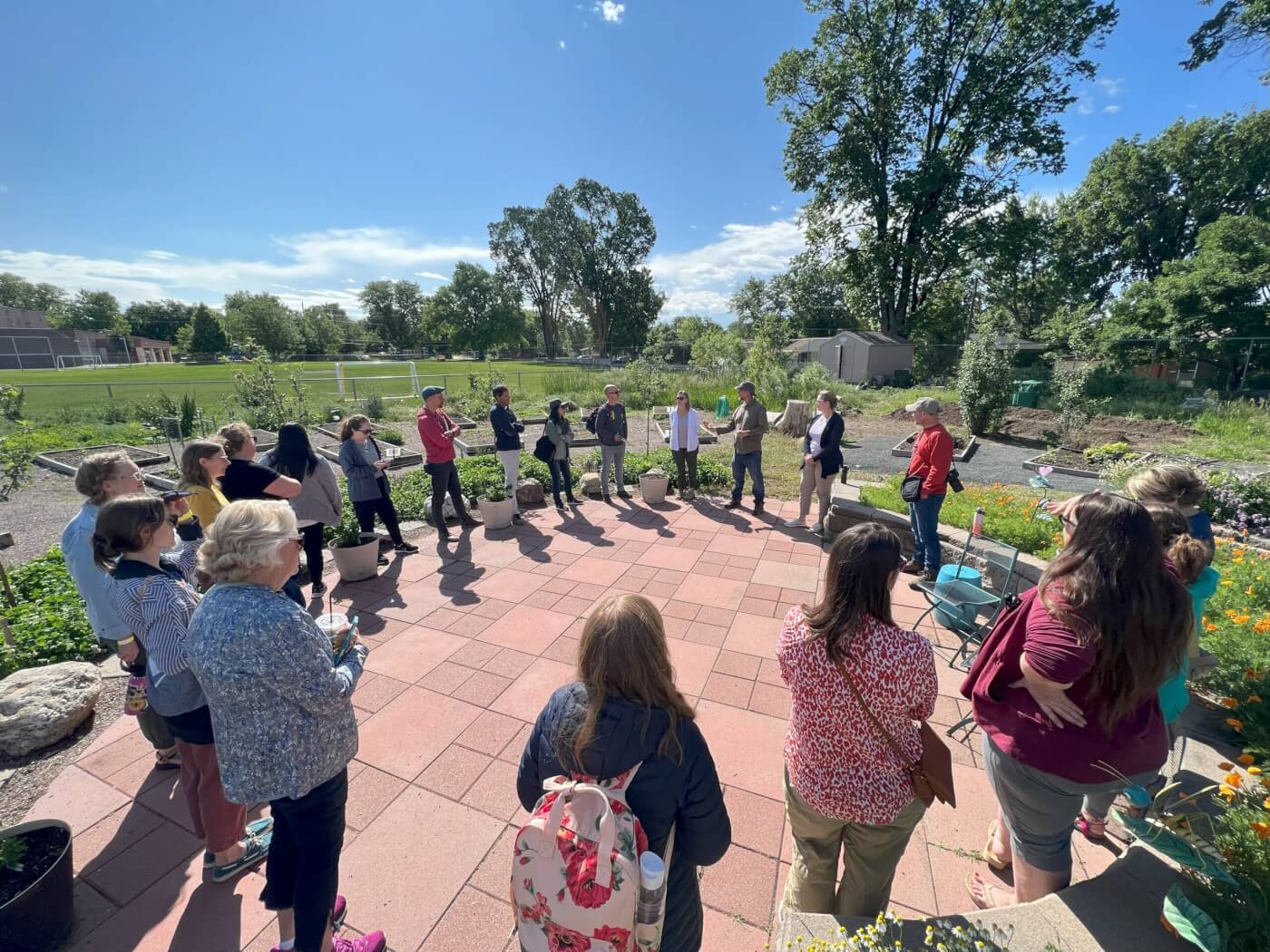
CCCN staff take cities on a peer learning field trip to gain insight into green schoolyards and early childhood nature connection. Photo courtesy of Brenda Kessler.
Technical assistance contributes to successful local systems change
In interviews and surveys, cities discussed the value of CCCN resources, tools and technical assistance. They named five primary forms of support that advanced their work the most: toolkits, in-person meetings, opportunities to connect with other CCCN cities, opportunities to connect with other CCCN staff members and one-on-one advising calls.

Cities assess the importance of five primary forms of support that CCCN provided. Data courtesy of Education Northwest and The Sustainable Learning Projects.
“The first interaction I had with a CCCN resource was the CCCN Municipal Action Toolkit, which just explores some of these big ideas. It’s where I saw both the concepts of early childhood nature play spaces and green schoolyards that really started this ball rolling: logging on and looking at all this information and these resources.”
– Prescott, Arizona
Most cities received some level of catalytic funding from CCCN and most said the funds had a major impact on their success: 78 percent of recipients said they “couldn’t have done this work without the money.” Others said the money was critical for communicating the importance of their work to city officials and ultimately, for the completion of their work.
“The importance of the catalytic funding at the beginning is what kept us afloat by doing small actions to keep the momentum moving forward to then grow into something bigger.”
– San Francisco, California
Many cities mentioned the importance of being affiliated with CCCN’s national partners. CCCN teams were able to leverage the support from national organizations to gain credibility for their efforts locally.
“I’ve learned over the years that if you bring an outside organization that has a national profile with money, people pay more attention.”
– Flagstaff, Arizona
“Being able to communicate to our team, our city department leads, and city leadership and say, ‘This is what the nation is doing, and we as Boulder are a leader in the nation – it really helps make the case.”
– Boulder, Colorado
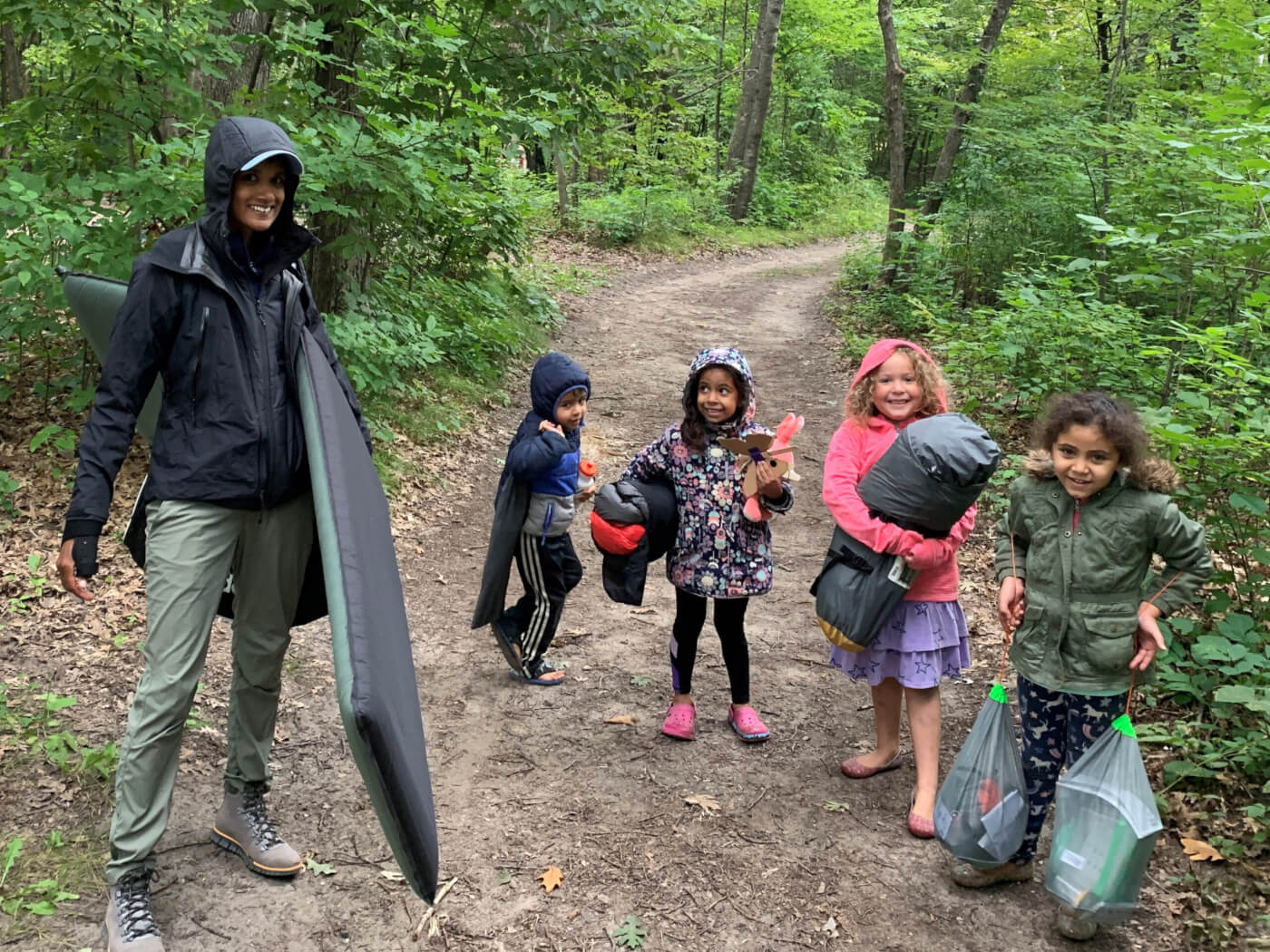
In St. Paul, Minnesota, the Parks & Recreation Department introduced nearly 330 campers to urban camping experiences between 2017 and 2019. Photo courtesy of the City of Saint Paul.
CCCN helps cities initiate partnerships and enact local changes
One of the main premises of the CCCN initiative is the belief that partnerships are essential for success. After a city joins CCCN, it’s recommended that they form a “city team” with members of various city departments and local organizations. While establishing partnerships and relationship-building takes time, investing in these relationships pays off in the long run – and the summative report proves it.
In several interviews, participants confirmed their city uses CCCN to harness existing momentum and develop partnerships that will help implement and sustain efforts. City teams said that CCCN participation helped them get buy-in from city leadership and connect with local organizations, with 59% reporting that they have successfully convened with community partners.
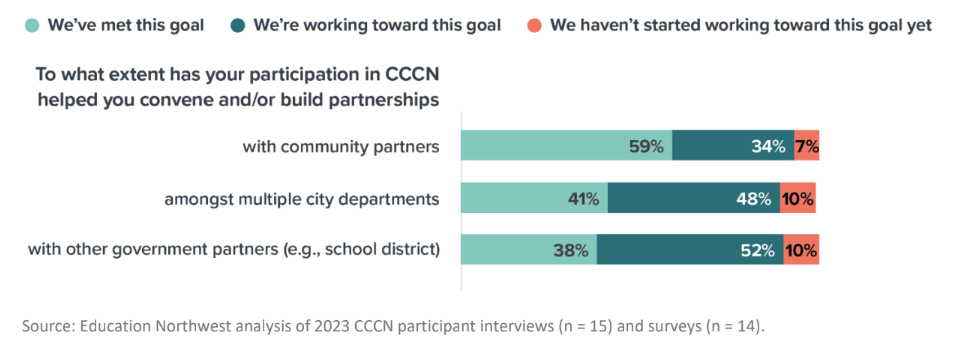
CCCN participation helps cities communicate with and engage city leaders, as well as community organizations. Data courtesy of Education Northwest.
“Collaboration is something our city is working to get better at. This work has truly opened the doors to how we can function, who is helping advance those efforts, and prioritized multilevel systems thinking.”
– Little Rock, Arkansas
“CCCN really got the mayor’s attention at that time. There was support before, but there was a lot more support after. Just engaging the leaders of our city, I think CCCN was instrumental in that for us.”
– Louisville, Kentucky
Respondents said that CCCN participation is also helping change the conditions that hold inequities in place. 62% reported that they are working toward identifying racial and other equity priorities, and 59% said they are working to shift policies, programs and infrastructure toward equitable children and nature connections.

CCCN participants have begun taking steps to change the conditions that hold inequities in place. Data courtesy of Education Northwest.
“Austin Parks and Recreation, Austin Independent School District and Austin Watershed were the three main departments working on [green schoolyards]. They sat down and thought, ‘How can we make a bigger impact?’ That’s where we identified things like changing education specifications for the city of Austin. It got put into a bond that just got passed. So, 20 new construction projects are happening that are going to have green schoolyards.”
– Austin, Texas
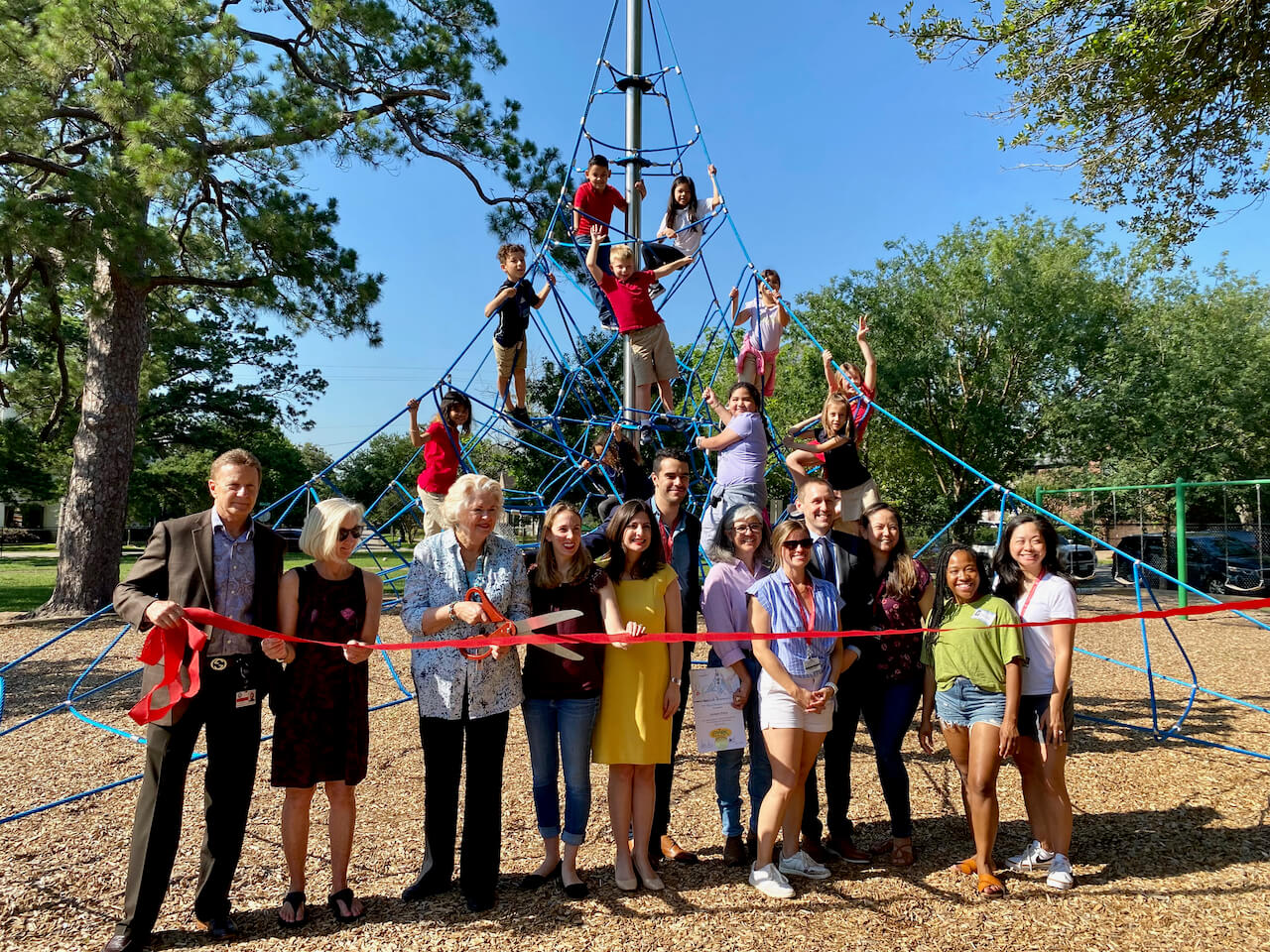
In Houston, Texas, the city partners with SPARK, a nonprofit that revitalizes school playgrounds to make them community parks.
Longer involvement with CCCN connects to more systems change results
As is expected, cities with longer support from CCCN felt they’d achieved greater outcomes in systems change. Of course, system changes take time and the changes CCCN encourages in cities are not quick and easy solutions. 71% of cities with six to nine years of CCCN participation report that they’ve implemented strategies to change the conditions that hold inequities in place, as opposed to 43% of cities that have only participated in CCCN for one year.
“One of the funders for Preschool Spaces has shifted their philosophy to only do nature play spaces and outdoor renovations. So that’s a big impact and a big shift, and that’s thanks to our collaborative work together that we never would have expected.”
– San Francisco, California
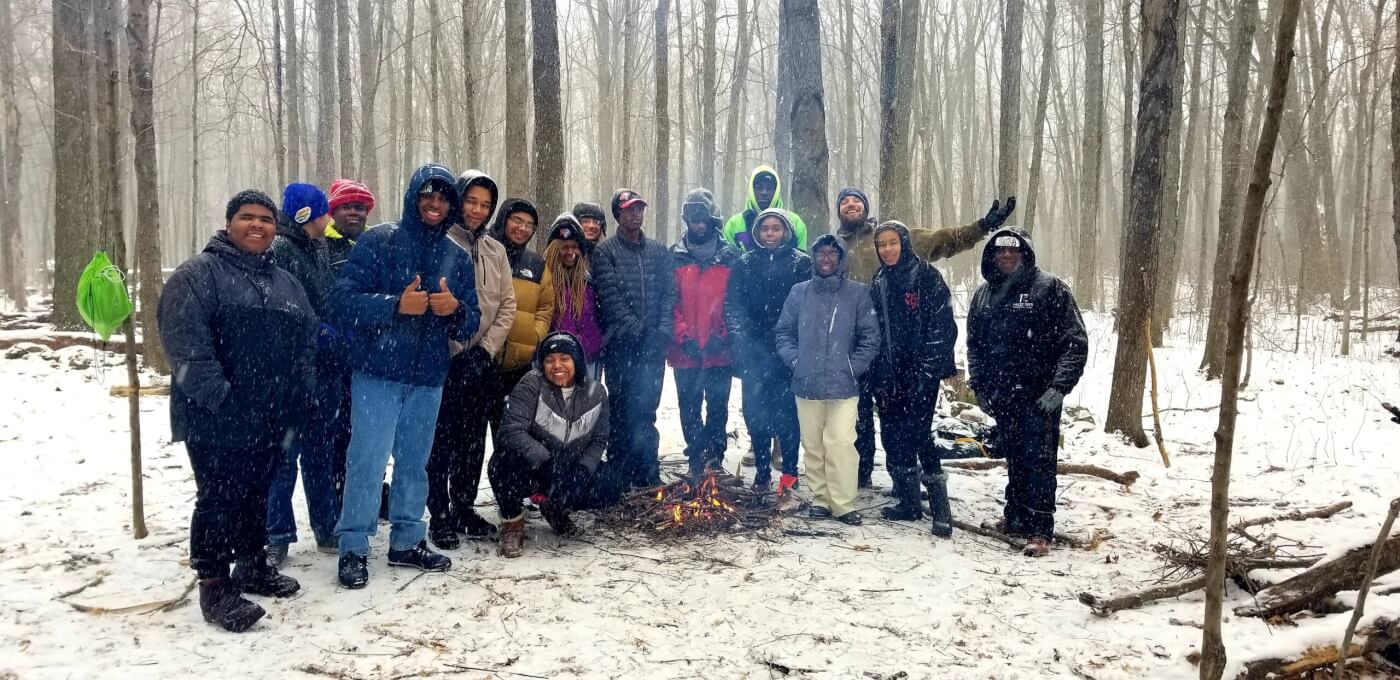
In Rochester, New York, the city engaged local youth and community members in creating a Children’s Outdoor Bill of Rights. Photo credit Stephanie Benway, City of Rochester.
Next phase: Nature Everywhere Communities
These findings point to the importance of continued support over time, especially to achieve CCCN program outcomes. While many CCCN participants have made progress on establishing key partnerships and implementing important nature connection strategies, no more than 20% of cities felt they had fully achieved at least one of CCCN’s ultimate program goals.
In order to help participating cities better assess their progress, researchers have recommended that partner organizations create a clear CCCN process map, adaptable to an individual city’s needs. Better communication with cities about what to expect along the CCCN journey will improve the process, results and ability to measure outcomes.
The National League of Cities and the Children & Nature Network are taking this recommendation and additional takeaways from the report to heart as they look at future partnerships and support for cities across the country through the Nature Everywhere Communities initiative.
Nature Everywhere Communities is a joint partnership of the Children & Nature Network, National League of Cities and KABOOM!, designed to increase equitable access to nature everywhere children live, learn and play in 100 communities by 2025.
“Over the past nine years, we’ve provided technical assistance, training, resources and grants to expand equitable access to nature for youth in more than 50 cities through the Cities Connecting Children to Nature initiative,” said Clarence Anthony, CEO and executive director of the National League of Cities. “Through the Nature Everywhere initiative, we are so excited to welcome a new cohort of leaders from across sectors in nineteen communities in advancing this effort.”
Last month, leaders from the 19 U.S. Nature Everywhere Communities gathered to share their goals and visions for connecting children and families to the benefits of nature during “vision labs” held in Austin, Texas, and Atlanta, Georgia. These Nature Everywhere Communities will continue a legacy that began 9 years ago and follow a path blazed by more than 50 cities through the CCCN initiative.
“Our first group of Nature Everywhere Communities expressed a wide range of goals and ideas. All of them demonstrated a deep commitment to the health and well-being of children – and the skills and cross-sector partnerships needed to be successful,” said Milligan-Toffler. “They join a powerful national network of cities and communities working to advance equitable access to nature everywhere children live, learn and play.”
Lessons Learned from the Cities Connecting Children to Nature Initiative
Creating Systems Change Toolkit
Equitable Access to Nature: A Systems Change Approach Video
In Prescott, Arizona, GIS maps give technical language to families in search of nature, a Finding Nature News story
Using a data-driven approach to invest in Atlanta’s children, a Finding Nature News story
In Flagstaff, green schoolyards sprout after climate-related disasters, a Finding Nature News story
Stumps, jumps and Tree Cookies: Bringing nature’s benefits to young children in cities, a Finding Nature News story
-
Network News
POLICY UPDATE: Policy and advocacy for the children and nature movement
-
Voices
Binoculars, bald eagles and my journey as a Black birder
-
Richard Louv
THE WONDER BOWL: Ten Spring and Summer Nature Activities for Kids and Adults
-
Network News
Minneapolis Spotlight: The promise and possibilities of parks for youth
-
Voices
Why nature is my motherhood ally


